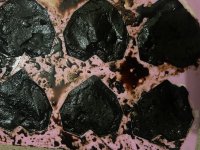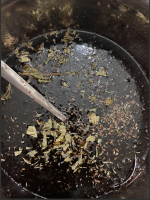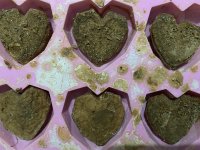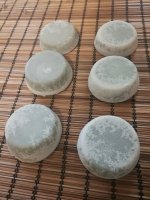urchin444
Rising Star
Hi guys; A few months ago, I shared my experience of making handmade soap in the chat area, and some people seemed interested in it. I promised to write an article explaining this in detail in the next few days at that time. But sorry for the post delay till now. Let's start to explain the details in detail, I hope you like it, thank you.
At first I was like people, after using a/b tek or stb and dumping the waste lye down the drain, after doing this a few times, it dawned on me. I might be able to make handmade soap from waste lye.
So as to turn waste into treasure, lye may have certain impacts on the environment after it is discharged into the sewer, including infiltration into deep soil, destroying soil acid-base balance, causing species damage, and in areas where community sanitation policies are not properly handled (they may put these Sewage is discharged directly into the sea...)
It should be noted that I have never made handmade soap before, I just learned from an Internet article that the mixture of lye and fat will form a saponification reaction, so my finished product looks like It doesn't look pretty, but I can guarantee that it will definitely not affect the use.
Just do it, here I will show you the basic logic and steps of making handmade soap (the details of each person's method may be different, in terms of raw materials, everyone can use their own creativity lol)
The concept of saponification reaction and the steps of making soap:
Saponification reaction: Saponification reaction is a chemical reaction, typically used in the preparation of soap. It is a reaction between alkali and fats (or fatty acids), facilitated by heating and stirring the mixture.
In the saponification reaction, alkali (such as sodium hydroxide or potassium hydroxide) reacts with the fatty acids present in the fats, breaking the ester bonds and producing glycerol and soap salts. Fatty acids in the fats are composed of glycerol and fatty acid molecules, While soap salts are the compounds that have cleansing properties.
This process involves an acid-base neutralization reaction between the alkaline and fatty acids, resulting in the formation of water and soap salts. Due to the hydrophilic nature of soap salts, they can absorb onto dirt in water and disperse and remove it from surfaces .
The saponification reaction is used not only in the manufacturing of traditional soaps but also widely applied in the production of cleansers, detergents, and personal care products.
The steps for making handmade soap are as follows:
1. Safety precautions: Ensure necessary safety precautions are taken before making handmade soap. Wear gloves, goggles, and long sleeves to protect against contact with chemicals such as lye.
2. Ingredient preparation: Select the desired oils, essential oils, and additives such as coconut oil, olive oil, cocoa butter, honey, or flower petals. Gather measuring cups, stirring sticks, containers, and molds.(Here I use coconut oil and flaxseed oil, soap made from coconut oil usually has good stain removal ability, and the soap will become harder after drying)
3. Determine the recipe: Based on the desired characteristics and purpose of the soap, determine a suitable recipe. The amounts and proportions of each oil used will affect the properties of the final product.
4. Lye solution: Using precise weighing tools, add the appropriate amount of lye (usually sodium hydroxide or potassium hydroxide) to a certain amount of water, stirring until fully dissolved. Note that this process generates heat, so caution is required.
5. Heating the oils: Heat the selected oils to an appropriate temperature, usually between 40-50 degrees Celsius. Use a thermometer to ensure the oils are within the desired range.(This step can be ignored, we directly pour the oil into the lye, it should be noted that the ph value of the lye must be above 10, otherwise the saponification reaction will not be sufficient)
6. Mixing lye solution and oils: Slowly pour the lye solution into the heated oils while stirring to facilitate the mixing reaction. Continue stirring until the mixture reaches a light trace, where it starts to thicken and leaves trails.(This step is quite critical. You must mix the oil and lye thoroughly. You need to use a manual or electric mixer, which will greatly improve efficiency. I don’t have a mixer. For me, this colander can also be used achieve the same effect)
7. Additives and essential oils: Add fragrances, colors, and other additives as desired. Essential oils can be used to add scents, while natural dyes or food coloring can be added to adjust colors.
8. Pouring into molds: Pour the mixture into prepared molds. Tap the molds gently to eliminate air bubbles.
9. Curing: Allow the handmade soap to rest in the molds for 24 to 48 hours to solidify. Then remove the soap blocks from the molds and place them in a well-ventilated area for 4 to 6 weeks to allow them to fully cure and dry.
10. Cutting and storage: Cut the cured and dried soap blocks into desired shapes and sizes, and store them in a well-ventilated area to prevent premature moisture absorption.
Please note that making handmade soap involves handling chemicals and working with high temperatures, so it is important to follow safety guidelines and conduct the process in a suitable environment. If you are a beginner, it is recommended to refer to tutorials from professionals or participate in relevant workshops.
At first I was like people, after using a/b tek or stb and dumping the waste lye down the drain, after doing this a few times, it dawned on me. I might be able to make handmade soap from waste lye.
So as to turn waste into treasure, lye may have certain impacts on the environment after it is discharged into the sewer, including infiltration into deep soil, destroying soil acid-base balance, causing species damage, and in areas where community sanitation policies are not properly handled (they may put these Sewage is discharged directly into the sea...)
It should be noted that I have never made handmade soap before, I just learned from an Internet article that the mixture of lye and fat will form a saponification reaction, so my finished product looks like It doesn't look pretty, but I can guarantee that it will definitely not affect the use.
Just do it, here I will show you the basic logic and steps of making handmade soap (the details of each person's method may be different, in terms of raw materials, everyone can use their own creativity lol)
The concept of saponification reaction and the steps of making soap:
Saponification reaction: Saponification reaction is a chemical reaction, typically used in the preparation of soap. It is a reaction between alkali and fats (or fatty acids), facilitated by heating and stirring the mixture.
In the saponification reaction, alkali (such as sodium hydroxide or potassium hydroxide) reacts with the fatty acids present in the fats, breaking the ester bonds and producing glycerol and soap salts. Fatty acids in the fats are composed of glycerol and fatty acid molecules, While soap salts are the compounds that have cleansing properties.
This process involves an acid-base neutralization reaction between the alkaline and fatty acids, resulting in the formation of water and soap salts. Due to the hydrophilic nature of soap salts, they can absorb onto dirt in water and disperse and remove it from surfaces .
The saponification reaction is used not only in the manufacturing of traditional soaps but also widely applied in the production of cleansers, detergents, and personal care products.
The steps for making handmade soap are as follows:
1. Safety precautions: Ensure necessary safety precautions are taken before making handmade soap. Wear gloves, goggles, and long sleeves to protect against contact with chemicals such as lye.
2. Ingredient preparation: Select the desired oils, essential oils, and additives such as coconut oil, olive oil, cocoa butter, honey, or flower petals. Gather measuring cups, stirring sticks, containers, and molds.(Here I use coconut oil and flaxseed oil, soap made from coconut oil usually has good stain removal ability, and the soap will become harder after drying)
3. Determine the recipe: Based on the desired characteristics and purpose of the soap, determine a suitable recipe. The amounts and proportions of each oil used will affect the properties of the final product.
4. Lye solution: Using precise weighing tools, add the appropriate amount of lye (usually sodium hydroxide or potassium hydroxide) to a certain amount of water, stirring until fully dissolved. Note that this process generates heat, so caution is required.
5. Heating the oils: Heat the selected oils to an appropriate temperature, usually between 40-50 degrees Celsius. Use a thermometer to ensure the oils are within the desired range.(This step can be ignored, we directly pour the oil into the lye, it should be noted that the ph value of the lye must be above 10, otherwise the saponification reaction will not be sufficient)
6. Mixing lye solution and oils: Slowly pour the lye solution into the heated oils while stirring to facilitate the mixing reaction. Continue stirring until the mixture reaches a light trace, where it starts to thicken and leaves trails.(This step is quite critical. You must mix the oil and lye thoroughly. You need to use a manual or electric mixer, which will greatly improve efficiency. I don’t have a mixer. For me, this colander can also be used achieve the same effect)
7. Additives and essential oils: Add fragrances, colors, and other additives as desired. Essential oils can be used to add scents, while natural dyes or food coloring can be added to adjust colors.
8. Pouring into molds: Pour the mixture into prepared molds. Tap the molds gently to eliminate air bubbles.
9. Curing: Allow the handmade soap to rest in the molds for 24 to 48 hours to solidify. Then remove the soap blocks from the molds and place them in a well-ventilated area for 4 to 6 weeks to allow them to fully cure and dry.
10. Cutting and storage: Cut the cured and dried soap blocks into desired shapes and sizes, and store them in a well-ventilated area to prevent premature moisture absorption.
Please note that making handmade soap involves handling chemicals and working with high temperatures, so it is important to follow safety guidelines and conduct the process in a suitable environment. If you are a beginner, it is recommended to refer to tutorials from professionals or participate in relevant workshops.






 .
.